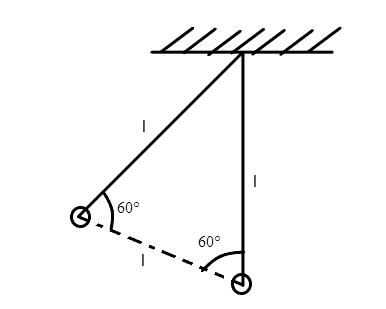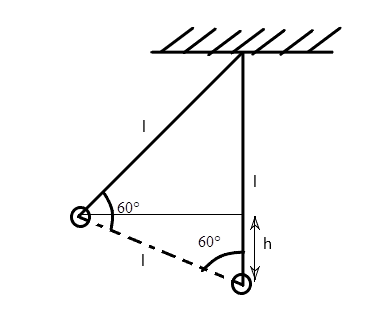
A bob hangs from a rigid support by an inextensible string of length \[l\] (from the lowest position) keeping the string straight, and then released. The speed of the bob at the lowest position is
A.\[\sqrt {gl} \]
B.\[\sqrt {3gl} \]
C.\[\sqrt {2gl} \]
D.\[\sqrt {5gl} \]


Answer
529.2k+ views
Hint: We need to use the principle of conservation of energy between the highest point and the lowest point. For calculation of potential energy, find the vertical distance of the bob at the highest position from the lowest position.
Formula used:
In this solution we will be using the following formulae;
\[PE = mgh\] where \[PE\] is the potential energy of a body from a reference point, \[m\] is the mass of that body, \[g\] is the acceleration due to gravity and \[h\] is the vertical height of the body from the reference point.
\[KE = \dfrac{1}{2}m{v^2}\] where \[KE\] is the kinetic energy of the body, and \[v\] is the velocity of the body.
Complete answer:

First, we see from diagram, that the height of the bob above the lowest point can be given by
\[h = l\cos 60 = \dfrac{l}{2}\]
Now, using the lowest point as the reference point, the potential energy of the bob can be found using the formula
\[PE = mgh\] where \[m\] is the mass of that body, \[g\] is the acceleration due to gravity and \[h\] is the vertical height of the body from the reference point.
Hence,
\[PE = mg\dfrac{l}{2}\]
Now, according to the principle of conservation of energy, all the potential at the highest point will be converted to kinetic energy at the lowest point. The kinetic energy is
\[KE = \dfrac{1}{2}m{v^2}\] where \[v\] is the velocity of the body.
Hence,
\[mg\dfrac{l}{2} = \dfrac{1}{2}m{v^2}\]
Hence, by making \[v\] subject of the formula, we have
\[v = \sqrt {gl} \]
Hence, the correct option is A.
Note:
For clarity, note that the point of reference is not essential to the calculation of the velocity, any point can be used as a reference point. The potential energy is always based on some point of reference.
Formula used:
In this solution we will be using the following formulae;
\[PE = mgh\] where \[PE\] is the potential energy of a body from a reference point, \[m\] is the mass of that body, \[g\] is the acceleration due to gravity and \[h\] is the vertical height of the body from the reference point.
\[KE = \dfrac{1}{2}m{v^2}\] where \[KE\] is the kinetic energy of the body, and \[v\] is the velocity of the body.
Complete answer:

First, we see from diagram, that the height of the bob above the lowest point can be given by
\[h = l\cos 60 = \dfrac{l}{2}\]
Now, using the lowest point as the reference point, the potential energy of the bob can be found using the formula
\[PE = mgh\] where \[m\] is the mass of that body, \[g\] is the acceleration due to gravity and \[h\] is the vertical height of the body from the reference point.
Hence,
\[PE = mg\dfrac{l}{2}\]
Now, according to the principle of conservation of energy, all the potential at the highest point will be converted to kinetic energy at the lowest point. The kinetic energy is
\[KE = \dfrac{1}{2}m{v^2}\] where \[v\] is the velocity of the body.
Hence,
\[mg\dfrac{l}{2} = \dfrac{1}{2}m{v^2}\]
Hence, by making \[v\] subject of the formula, we have
\[v = \sqrt {gl} \]
Hence, the correct option is A.
Note:
For clarity, note that the point of reference is not essential to the calculation of the velocity, any point can be used as a reference point. The potential energy is always based on some point of reference.
Recently Updated Pages
Why are manures considered better than fertilizers class 11 biology CBSE

Find the coordinates of the midpoint of the line segment class 11 maths CBSE

Distinguish between static friction limiting friction class 11 physics CBSE

The Chairman of the constituent Assembly was A Jawaharlal class 11 social science CBSE

The first National Commission on Labour NCL submitted class 11 social science CBSE

Number of all subshell of n + l 7 is A 4 B 5 C 6 D class 11 chemistry CBSE

Trending doubts
What is meant by exothermic and endothermic reactions class 11 chemistry CBSE

10 examples of friction in our daily life

One Metric ton is equal to kg A 10000 B 1000 C 100 class 11 physics CBSE

1 Quintal is equal to a 110 kg b 10 kg c 100kg d 1000 class 11 physics CBSE

Difference Between Prokaryotic Cells and Eukaryotic Cells

What are Quantum numbers Explain the quantum number class 11 chemistry CBSE




